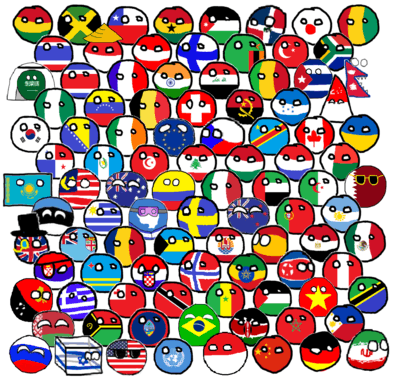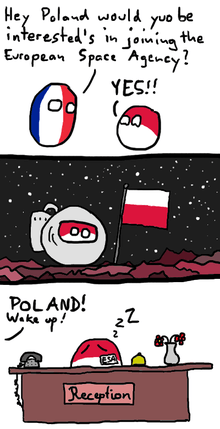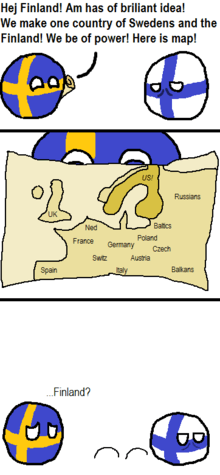Polandball
Polandball, also known as countryballs, refers to user-generated visual art, typically manifesting as online comics, where countries are personified as (typically) spherical personas decorated with their country's flag, interacting in often broken English (with the exception of countryballs that speak English natively), usually with regional and/or national variations (e.g. France's Engrish is interspersed with French words). The characters poke fun at national stereotypes and international relations, as well as historical conflicts. Countryballs have also been used in videos and comics involving alternate and speculative history. It is an Internet meme which originated on the /int/ board of German imageboard Krautchan.net in the latter half of 2009.

The comics style may be referred to both as Polandball (by convention, even in cases where there is no Poland among the cartoon characters) and countryball (or, collectively, countryballs).
Background

Polandball has its roots in an August 2009 "cyberwar" between Polish Internet users and the rest of the world on drawball.com. The website, which offers a virtual canvas, allows Internet users to draw whatever they want, and to draw over others' drawings. On the Polish internet, an idea was raised to draw the Polish flag on the ball, and thousands of Poles together managed to take over the drawball with a painting of white on top of red, with the word "POLSKA" written in the middle. After co-ordination from 4chan, this was then covered over by a giant swastika, an interaction which was repeated several times over the ensuing weeks.[1][2]
Krautchan.net was a German-language imageboard whose /int/ board was frequented by English-speaking netizens. The beginning of the Polandball meme is credited to Falco, a British user on /int/, who created the meme in September 2009 using Microsoft Paint in an apolitical way to troll Wojak, a Pole on the same board who contributed in broken English, after which Polandball cartoons were enthusiastically drawn by Russians.[1][3][4]
Polandball comics have no defined authors, and anyone is able to make one.[5] This has become an internet meme, presented e.g., on Reddit[4][6] and Facebook.[7][8]
Themes
Poland

The premise of Polandball is that it represents Poland and its history, relations with other countries and stereotypes,[3][9] focusing on Polish megalomania and national complexes.[2][10] With the exception of English-speaking ones, interactions between countryballs tend to be written in broken English and Internet slang, reminiscent of the lolcat meme, and by the end of the cartoon Poland, which is purposely represented as red on top of white (the reverse of the Polish flag), is typically seen weeping.[1][2]
Polandball depiction of Poland portrays a number of stereotypes. These include bad English use by Poles, blaming others for its failures in particular given the backdrop of repeated invasions by Russians and Germans (such as the 18th century partitions and World War II), Polish propensity for telling tales of the glorious past, and the perception of Poles as "dull-witted" and "psycho-Catholic".[11]
Some Polandball comics arise from the premise that Russia can fly into space, whilst Poland cannot.[12][13] One of the earliest Polandball comics begins with the premise that Earth is going to be struck by a giant meteor, leading to all countries with space technology leaving Earth and going into orbit around the planet. At the end of the cartoon, Poland, still on earth, is crying, and in broken English pronounces the canonical Polandball catchphrase "Poland cannot into space".[3][14] In this humorous way, Russians put a halt to all discussion with Poles on which country is superior.[1][3][9]
Other countries
Polandball can also include comics on other countries, but by convention these comics are usually still referred to as Polandball comics,[1] although they are sometimes also referred to as countryballs.[4] States, provinces, and other such divisions can also be used; multi-national organizations such as the European Union and United Nations are also common, but their lack of power compared to their constituent states means that they are portrayed as weak or puppets. Countries are also represented as balls,[5] although there are many novel exceptions. The German Empire of 1871–1918 (on Facebook and elsewhere) or the theoretical Fourth Reich (on Reddit) is represented as a version of the German Empire's flag with a ratio of around 4:3 with small eyes known as Reichtangle (a portmanteau of the words 'Reich' and 'Rectangle', also a pun). The German Empire's general historical hostility towards Poland has established Reichtangle as the main antagonist. Israel as well as the Jewish Autonomous Oblast takes the form of a hypercube (in reference to Jewish physics); the state of Michigan is also commonly depicted as a cube. Nepal (sometimes called Nepalrawr) is in the shape of its national flag (one triangle on top of another) and has teeth; other pennant-shaped flags can be drawn as "rawrs", such as the Maratha Empire and the state of Ohio. Singapore, Bermuda, and more rarely the Colombian department Nariño take the form of a triangle, in which Singapore is sometimes referred to as Tringapore. Kazakhstan takes the form of a brick sometimes called Kazakhbrick, due to Kazakhstan being the only country whose flag icon was inadvertently not changed to a ball on Krautchan.[15] Omsk, a city in Russia, generally takes the form of a malevolent humanoid bird (based on an earlier internet meme), and is based on a drawing by German artist Heiko Müller titled "Winged Doom".[16]
There are various other established conventions. The 'r's and 'l's in East Asian nations' speech switch places in a stereotypes of East Asians. The United States sports a pair of shades and often has its stars replaced by the text "x50", and regularly uses profanity. It regularly mistakes countryballs without a direct historical and/or political connection to it either for their neighbors or with those with similar flags. Japan sometimes wears cat ears, the United Kingdom wears a monocle and a top hat (as does Hong Kong, since it was once a territory of the United Kingdom) and Canada is often seen wearing a coonskin cap.[17] Indonesia is always drawn with either a songkok or Asian conical hat to distinguish it from Poland (given its upside-down flag), with Monaco also distinguishing itself by often being drawn extremely small and with a pair of dark shades. Argentina, Uruguay and Paraguay are sometimes wearing a mate pot. Vatican City also regularly wears a mitre. Countries whose emblems are offset to the hoist of their flags (i.e. Serbia, Spain, Portugal and Slovakia) are usually depicted with the emblem as an eyepatch, with Austria-Hungary often being depicted as blind while wearing two eyepatches. The orientation of the star and crescent on the flag of Mauritania gives the appearance that this countryball are perpetually smiling, and the stars on the flag of Venezuela give the illusion that this countryball is perpetually sad. India is sometimes shown wearing a turban with some Hindu and traditional markings on its forehead. Sealand and other micronations are often shown as being eager to assert their statuses as real nations, in spite of disagreements from other established nations or from each other. Antarctica, represented by the Graham Bartram flag, is depicted as mute as it has no native language. Finally, certain ethnic groups without a flag of their own are depicted as billiard balls based on skin colour, such as the black 8-ball representing indigenous Africans.
The simplicity of Polandball, added with its recognition of world history and a focus on current affairs, makes the meme suited to commenting on international events.[5] Amongst events which have been covered by Polandball and have been noted in the media, are the Senkaku Islands dispute,[18] the 2013 papal conclave which saw Jorge Mario Bergoglio being elected as the new Pope,[19] the 2014 Ukrainian crisis,[5][14][20] the 2014 Crimean crisis[6] and issues relating to Filipino workers in Taiwan.[21]
Assessment

A report on the Russian radio station Vesti FM noted a post on Livejournal which asked readers to list five images that come to mind when thinking of Poland or Poles. The five pages of responses, illustrating the deep historical ties between Russia and Poland, recalled subjects including False Dmitriy I, Tomek in the Land of the Kangaroos by Polish author Alfred Szklarski, Czterej pancerni i pies ("Four tank-men and a dog"), Russophobia and Polandball.[22]
Wojciech Oleksiak, writing on culture.pl, a project of the Polish government-funded Adam Mickiewicz Institute which has the aim of promoting Polish language and culture abroad, noted that due to anyone being able to create a Polandball comic, the existence of the meme has created new opportunities for people to express their personal views on race, religion and history. In describing Polandball as the Internet par excellence, he further stated that comic plots can be "rude, impolite, racist, abusive, or just plain dumb", whilst also noting that the politically incorrect nature of the comics add to the attractiveness of the meme.[23]
At the same time, Oleksiak notes that Polandball comics often employ exaggerated Polish stereotypes, such as Poles not being as proficient in English as other nationalities, and Poland itself being a country full of dull-witted psycho-Catholics. On the other hand, some stereotypes employed in Polandball comics, such as Poles telling stories about the nation's glorious history and dwelling on a deep rooted martyrdom, are mostly true; whilst the stereotype that Poles hold many national complexes and blame external forces for their own failures, is true, but somewhat justified.[23]
Oleksiak further notes that from Polandball, Poles can learn to have "a sense of humour about our long-time grudges".[23]
See also
- Hetalia: Axis Powers
- International relations
- National personification
- Polish joke
References
- Orliński, Wojciech (5 August 2014). "Wyniosłe lol zaborców, czyli Polandball" (in Polish). Gazeta Wyborcza. Archived from the original on 1 January 2012. Retrieved 6 August 2014.
- Zapałowski, Radosław (15 February 2010). "Znowu lecą z nami w... kulki" (in Polish). Cooltura. Archived from the original on 5 August 2014. Retrieved 6 August 2014.
- Kapiszewski, Kuba (5 April 2010). "Fenomem — Polska nie umieć kosmos" (in Polish). Przegląd. Archived from the original on 5 August 2014. Retrieved 5 August 2014.
- Plomlompom, Nils Dagsson Moskopp Erlehmann & Christian Heller (2013). "MS-Paint-Comics". Internet-Meme : kurz & geek (in German) (1 ed.). O'Reilly Verlag. pp. 86–88. ISBN 978-3-86899-806-1. Retrieved 5 August 2014.
- Fisher, Max (25 July 2014). "Is there a series of irreverent political cartoons summing up the crisis?". Vox Media. Retrieved 6 August 2014.
- Ryan, Emmet (4 March 2014). "Polandball is Reddit's answer to Crimea crisis". The Sunday Business Post. Retrieved 8 November 2014.
- "dzien dobry, friend".
- "POLANDBALL".
- Cegielski, Tomek (12 April 2011). "MEMY. Legendy Internetu" (in Polish). Hiro.pl. Archived from the original on 15 April 2011. Retrieved 5 August 2014.
- Kralka, Jakub (11 May 2012). "Polski internet to potęga, po co te kompleksy?" (in Polish). Spider's Web. Archived from the original on 5 August 2014. Retrieved 5 August 2014.
- "Mirosław Hermaszewski – pierwszy Polak w kosmosie". PolskieRadio.pl. Retrieved 22 June 2019.
- Камышин «может в кантриболз». Infokam (in Russian). 7 August 2014. Archived from the original on 8 November 2014. Retrieved 8 November 2014.
- "FAQ's and Ask the Mods! • r/polandball". reddit. Retrieved 12 July 2017.
Why is Kazakhstan a brick? On Krautchan when the country flags were changed to balls, the Kazakhstan flag stayed a normal rectangle initially. Thus it became a brick.
- "Into the beast's lair • r/polandball". reddit. Retrieved 3 November 2018.
Yeah, he's from a 2009 drawing by German artist Heiko Müller titled "Winged Doom", which eventually became associated with a meme about shooting drugs in the city of Omsk through a Russian chan site. Since Polandball was in its infancy at that time, and was also born in the chans, the two bled together despite Omsk Bird having no logical connection. Today Omsk Bird keeps its association with drugs, but in comics is also generally represented as a malicious and powerful entity.
- Hoffman, Steven (2 May 2015). "How Polandball can of taking over internets". Krakow Post. Retrieved 2 April 2016.
- "Japon, Chine, vers une nouvelle guerre froide". France Culture (in French). 9 March 2013. Archived from the original on 8 November 2014. Retrieved 8 November 2014.
- "Wybór Franciszka okiem internautów" (in Polish). Onet.pl. 14 March 2013. Archived from the original on 6 August 2014. Retrieved 6 August 2014.
- Аниматор из Камышина нарисовал мультфильм о «заболевшей» Украине. Argumenty i Fakty (in Russian). Volgograd. 6 August 2014. Archived from the original on 8 November 2014. Retrieved 8 November 2014.
- "台灣最美麗的風景是人 真的嗎? (Taiwan is one of the most beautiful landscapes, really?)" (in Chinese). Apple Daily (Taiwanese edition). 31 July 2014. Archived from the original on 6 August 2014. Retrieved 6 August 2014.
- Klava, P. (25 August 2013). Польша у россиян ассоциируется с Лжедмитрием и Польшаром. Vesti FM (in Russian). Archived from the original on 8 November 2014. Retrieved 8 November 2014.
- Oleksiak, Wojciech (9 June 2014). "Polandball — A Case Study". Culture.pl. Adam Mickiewicz Institute. Archived from the original on 6 August 2014. Retrieved 6 August 2014.